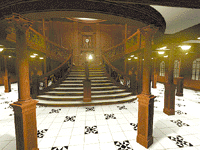
South Hampton, England was where the Titanic picked up her first passengers on April 10,1912. The Titanic set sail for Ireland to pick up more passengers. After all the passengers were on board and shown to their rooms, the ship left Ireland to sail across the Atlantic to New York. Would this beautiful and very large ship make it to New York? The Titanic was one of the ships built by the White Starliner Ship building company of England. At that time it was the largest ship to ever set sail. It weighed 46,000 tons, and was four blocks long (882.5ft.) Also it was eleven stories tall ( 175 ft. from waterline to the top of the funnels), and 92.5 ft. wide in the center. Newspapers called this ship the "wonder ship," and the "unsinkable ship" because of her double hull, and sixteen watertight compartments in the bow and the stern, and fifteen watertight bulkheads running clear across the ship. This ship was also one of the fastest ships in the world. The Titanic had two sets of four cylinder reciprocating engines producing 50,000 horsepower, but could develop at least 55,000 horsepower easily, and its full speed was 24 or 25 knots.
When the Titanic was leaving South Hampton, it narrowly missed a head on collision with the American Liner New York. Right after the Titanic left South Hampton a coal fire broke out in the engine room, but the Captain did not go back to the dock. Once the ship stopped at Ireland and picked up all of her passengers, there were between 2,220 and 2,250 people on board. There were 900 crew members, and 1,320 passengers on board.

The 325 first class passengers could enjoy a swimming pool, the first ever on a ship, plus a gym, squash court, sauna, and a library. They could eat in a 500 seat dining saloon, a smaller private restaurant, or a French sidewalk cafe. The average first class suite could cost anywhere from $1,300-$13,000 in today's money. There were 700 third class passengers which didn't get the same kind of treatment as the first class passengers did. An average third class passenger paid just $32 for a one way ticket. The Captain was the 62-year-old veteran Edward J. Smith. It was said that he was trying to set a record of the fastest crossing of the Atlantic The crossing was going along fine; all the passengers were having a great time. Then on that fateful night of April 16 the impossible happened. The Titanic hit an iceberg and sank. The other ships that were in the area of the Titanic were radioing in that there was an ice field in front of the Titanic. Most of the messages that were sent in were posted but not sent to the bridge of the ship. The ones that made it to the bridge the captain almost ignored. He told his crew to keep a sharp eye for ice, but he didn't slow the ship. No ship slowed until ice was sighted, he thought, why should the Titanic. At seven p.m. there was no moon and the temperature was very cold at 43ºF, and almost all of the passengers were inside eating dinner. It was dark outside, and the lookout in the crows nest could hardly see. At eleven p.m. the temperature was freezing, and visibility was at almost nothing. As the chief operator struggled to send ship-to-shore messages, a message from the California, which was some 19 miles to the northwest, was reporting ice had forced them to stop for the night. He shrugged this message off. He wired back, and said "shut up." This made the chief operator of the California mad, and he turned off his radio.

At 11:40 p.m. the lookout saw an iceberg looming ahead and called the bridge. The captain was I bed, so the co-captain reversed the engines and tried to turn sharply to port. The Titanic hit the iceberg, which stood as high as the top deck. The rock-solid ice popped rivets and opened metal plates letting sea water pour into the first five compartments along a narrow 300-ft. long area. The crew started loading lifeboats and sending out C.Q.D and the brand new S.O.S distress signals, which the California didn't pick up. They didn't understand why the Titanic was sending off distress rockets. They thought they were fireworks from a party. The Carpathia picked up the S.O.S signal, but she was 58 miles to the south, and her top speed was only 17 knots. It would take her two hours to get there, but she would try. British regulations which had last been updated in 1898, said ships of more than 10,000 tons only needed lifeboats for 980 persons. No problem there--the Titanic had 20 boats which would hold 1,178 people 200 more than required. The builder of the ship had given the ship one hour to live, but it took her almost two hours to sink. The Titanic split into three pieces, not into two pieces like thought at first. When it was all over the Carpathia picked up 705 survivors, and figured there were about 1,522 dead. I believe if the Titanic had not turned to port, and hit the iceberg head on maybe it would have only flooded two or three compartments, and the Titanic might have made it to New York and recieve needed repairs. This might have saved the lives of 1,522 people. I write this report in memory of all those people who died in this tragedy.
Back Home Helen Hunt Mad About You